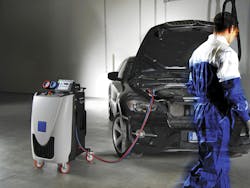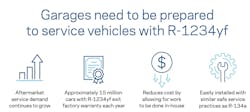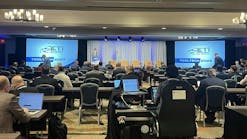What you need to know about R-1234yf
The automotive industry has progressed steadily along the timeline of acceptance and adoption of R-1234yf, the new-generation refrigerant poised to eventually replace the legacy R-134a, a hydrofluorocarbon (HFC).
The journey started in 2011, when the European Union began phasing out use of HFCs, ultimately requiring that all new light-duty vehicles entering the market be charged with a lower global warming potential (GWP) refrigerant like R-1234yf, a hydrofluoroolefin (HFO).
A turning point in U.S. adoption came in 2018, when General Motors achieved full conversion to R-1234yf systems. This paved the way for other manufacturers in the U.S., Asia, and Canada to follow suit. Regulatory influences such as the American Innovation and Manufacturing (AIM) Act — which, on Jan. 1, 2024, required an additional 30% reduction in HFC production and consumption — and Significant New Alternatives Policy (SNAP) listings for new acceptable R-1234yf applications have also contributed to expanded use of the HFO refrigerant in the automotive industry.
This history has driven and accelerated the need for aftermarket shop owners and technicians to have the ability to service internal combustion engine and electric vehicles that use R-1234yf. There are more than 95 million vehicles on U.S. roads charged with R-1234yf. The R-1234yf fleet size is significant — currently around 30% — and growing. And, every year, 15 million vehicles are removed from service.
As a result, more of them are appearing in shops for service. As demand for service increases, shops can reduce costs — and retain and even grow business — by properly equipping themselves to keep R-1234yf jobs in-house.
One of the strongest and most encouraging indications that a larger portion of the aftermarket industry is preparing for — or actively engaged in — this transition comes from the increasing number of questions being fielded by our sales and customer service teams for R-1234yf. Here are some of the most frequently asked questions we’re hearing:
Are R-1234yf vehicles serviced the same as R-134a vehicles?
There are similarities but also some differences, due to R-1234yf’s mild flammability. Be sure to read the SDS and owner’s manual to make sure you have the correct tools — for example, R-1234yf requires left-handed thread fittings and a separate R/R/R machine.
Why is there a noticeable price difference between the two refrigerants, and what do you get for the expanded cost of R-1234yf?
R-1234yf is a relatively new refrigerant and is manufactured using a more complex process than R-134a. To design an environmentally safe product for the automotive industry, manufacturers must follow in-depth safety and validation steps during product development to meet industry requirements. With R-1234yf, you get a non-ozone-depleting, low-GWP refrigerant that has become the standard for most automotive manufacturers globally. R-1234yf has a GWP of less than 1 — compared with R-134a’s GWP of 1,300 — and is therefore less harmful for the planet.
If R-1234yf is relatively new. Will I have to worry about its availability as my shop’s need for it increases?
Not at all. The supply chain of R-1234yf is extremely strong and positioned to support its adoption globally. In fact, Chemours, which operates one of the world’s largest manufacturing facilities of R-1234yf, recently engaged in an $80 million capacity-expansion project to increase facility production by 40%. We will continue to make investments necessary to meet market demand.
How can I tell if a vehicle in my shop uses R-134a or R-1234yf?
You can either consult the owner’s manual or check under the hood for the SAE label that shows the type of refrigerant the vehicle uses.
If an R-1234yf vehicle comes into my shop, can I service it with R-134a?
No. First, it is illegal to use R-134a in an R-1234yf-charged vehicle. In addition, it can be dangerous to mix the two. Doing so can also invalidate warranties, cause problems with the system’s performance and efficiency, and may lead to system damage or failure. Lastly, safeguards are in place to prevent technicians from using R-134a in an R-1234yf vehicle. For example, R-1234yf requires left-handed thread fittings, whereas R-134a fittings are right-hand threaded. You will also notice differences in service cylinders (DACS, cans); vehicle service fittings (Schrader valves); and R/R/R machines.
Do I need a license to service an R-1234yf vehicle?
If you are purchasing less than 2 pounds of either R-134a or R-1234yf, you are not required to have a license to purchase either refrigerant. However, if you are working with 10- and 25-pound single-use recyclable cylinders you will need Section 608 Technician Certification. The EPA requires this, under section 608 of the Federal Clean Air Act, for technicians who maintain, service, repair, or dispose of equipment that could release refrigerants into the atmosphere.
What are my size/packaging options for R-1234yf?
Chemours Opteon YF is packaged to meet a variety of needs for DIYers as well as for shops — based on your size and how much business you are doing. Options currently available are:
- 10- and 25-pound single-use recyclable cylinders — ideal for shops that perform a high volume of AC work; these require an appropriate R/R/R machine.
- 28-ounce self-seal can — provides a cost-effective option for multiple-use charges, or for servicing vehicles with greater charge sizes (such as SUVs and trucks), without the need for an R/R/R machine.
- 12-ounce self-seal can — provides a cost-effective option for single-use charges, without the need for an R/R/R machine.
- 12-ounce self-seal can with reusable charging hose — offers a quick-connect coupler for easy low-side port connection.
In May The Chemours Co. be back in Motor Age with another installment in this questions-and-answers series. The second part will address questions of a more technical nature. In the meantime you can learn more about R-1234yf and access product information bulletins and more at opteon.com/YF.




